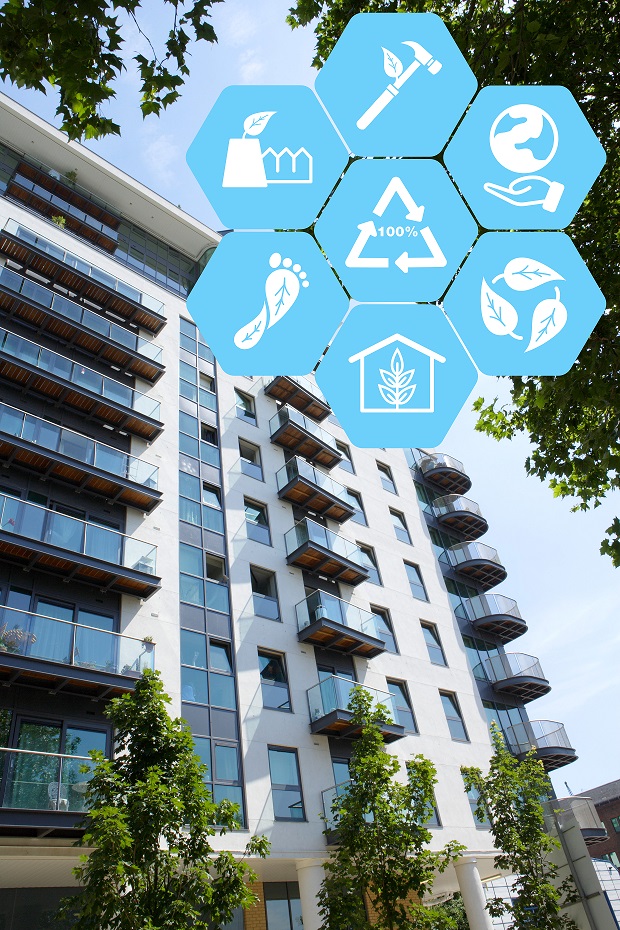Recycled PVCu Beads Render Steel Alternatives Unsustainable
Render beads provide clean lines and a smart modern finish to rendered facades whilst providing a key to the render and protection from impact damage

While a small part of the overall building project, they see widespread use across different types of structures. In the past, before PVCu was a common building material, stainless steel has often been the preferred material for this application, but the benefits of reduced carbon and the high performance of PVCu alternatives are driving a shift in the market.
Sustainability is a big issue in construction. During 2021, the industry was responsible for over 10 million tonnes of carbon dioxide emissions in the UK alone1. When building sustainability into homes or structures, the details matter. Even a small environmental benefit, like choosing more sustainable materials for often overlooked components, is multiplied over a large development. Considering this, numerous modern construction projects have been utilising PVCu beads from Renderplas. Made from up to 100% recycled materials, these beads offer a sizeable reduction in carbon footprint when compared to traditional stainless steel alternatives.
The carbon cost of stainless steel
The fact that stainless steel production is carbon intensive is no secret. The International Stainless Steel Forum (ISSF), using data from its members and Yale University, calculated that the total CO2 cost of producing a ton of stainless steel with 50% recycled scrap equated to 2.9 tons2. This encompasses extraction of ores, manufacture of alloys, the stainless steel production process and the large amount of energy required for all stages.
Building sustainably means utilising less polluting materials. Therefore, finding a robust, suitable alternative to steel during the planning stage can contribute to lowering the carbon footprint of a project.
Getting a bead on sustainability
Recycled PVCu offers a distinct advantage in this regard. Conducting a cradle to grave analysis over a projected lifespan of 100 years, an independent assessment found that the PVCu in Renderplas beads only produced 0.74 tons of CO2 equivalent per ton installed3. This makes the lifetime carbon footprint of a PVCu bead nearly four times less than the production of stainless steel as a raw material. This is before the additional manufacturing to actually make a stainless steel bead, which is also energy intensive.
The reason for such environmental performance is that Renderplas uses recycled PVCu. It utilises 100% of this material in its white stop beads, corner beads and bellcast beads - while its movement joints and beads of other colours contain a minimum of 75%. This approach means that Renderplas products can be produced using less resources and energy.
In common with stainless steel, offcuts from installation can be recycled, just like the complete PVCu bead after deconstruction. Forgoing the widespread usage of virgin raw materials, including plastics, means Renderplas’ designs compare favourably with other materials too. The company estimates that the environmental impact of using a PVCu extrusion with no recycled material is six times worse than using Renderplas recycled products. Furthermore, unlike steel, PVCu offcuts can be recycled easily at the manufacturing site.
The role of recycled PVCu render beads in sustainable developments is illustrated by their compliance with government Part L building regulations, which are steadily reducing the carbon footprint of all new homes. With the latest regulations looking to be more ambitious and innovative than ever before, choosing Renderplas products actively contributes to improving sustainability in construction.
Environmental benefits beyond construction
High performance in application maximises the environmental benefits. Guaranteed to match the lifetime of the render, or to last at least 25 years, PVCu beads outlive their metal counterparts. This is thanks to superior corrosion, impact and spalling resistance. Such qualities enable a longer gap between replacement, saving further resources. Renderplas beads also eliminate the cold bridges synonymous with steel designs, improving building insulation and energy efficiency.
Recycled PVCu complies with Registration, Evaluation, Authorisation and restriction of Chemicals (REACH) legislation. This ensures that the material is ecologically benign, non-hazardous in watercourses and non-toxic if ingested.
Starting small with sustainability
Daniel Leedham-Green, Managing Director at Renderplas, concludes: “We are under no illusions that beads for plastering or rendering are a very minor part of a construction project. However, when improving sustainability, small gains add up over a large development. Recycled PVCu beads offer contractors, builders and architects an easy sustainability win for any structure, providing a one-to-one replacement for stainless steel designs with no compromise in application performance.”
CONTACT
Daniel Leedham-Green
Renderplas Ltd
Daniel.Leedham-Green@renderplas.co.uk
www.renderplas.co.uk
+44 1299 888330
Tuesday 28 November 2023 / file under Architectural | Construction | Engineering



